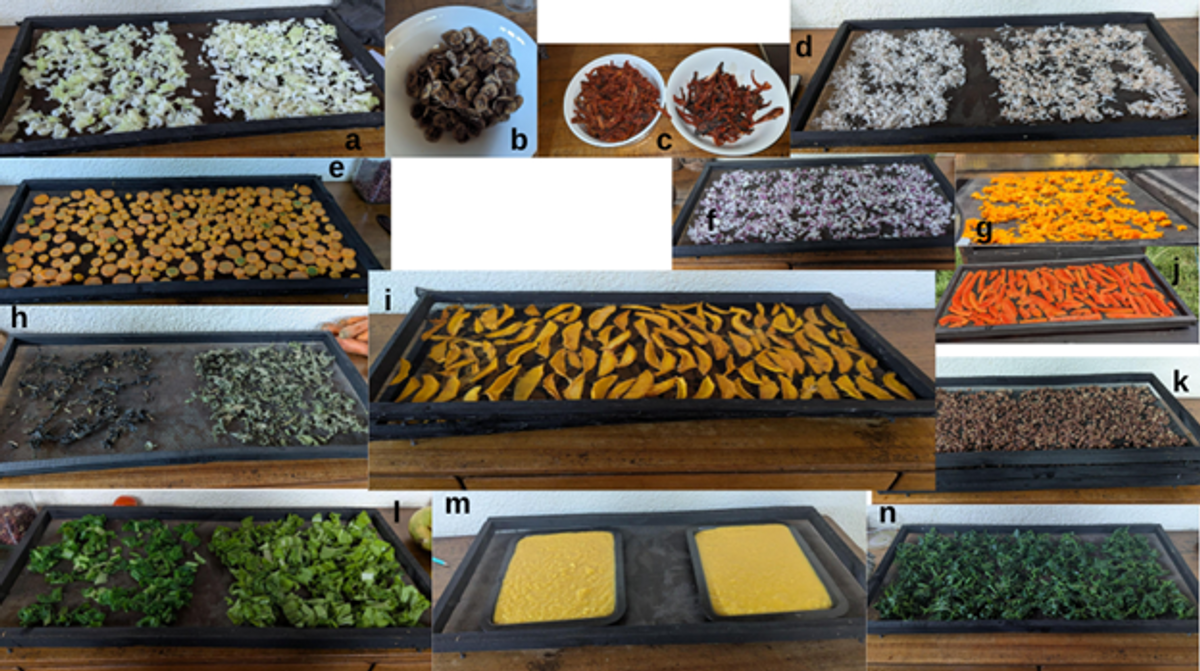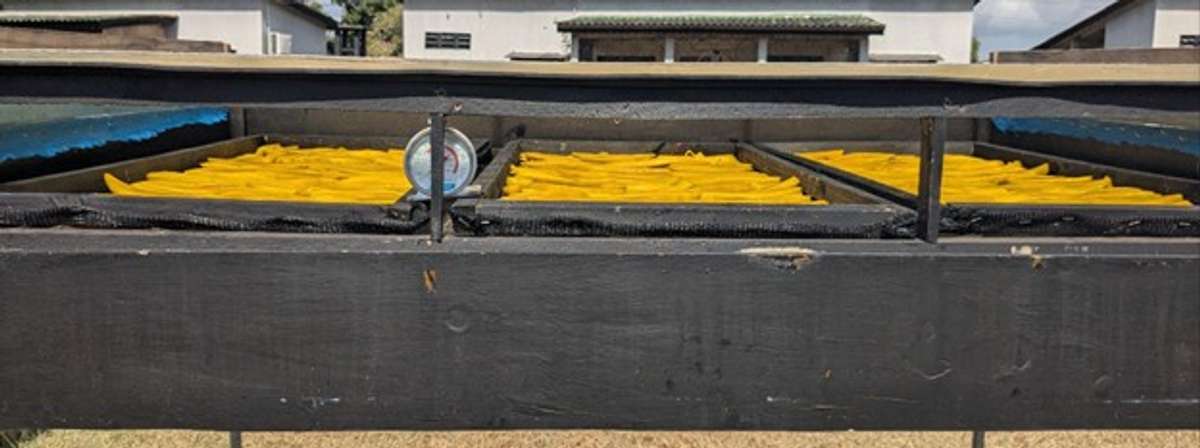Introduction
Drying food with the help of the sun for prolonged storage and preservation is a long-time practice for farmers and fishers all across the world. Drying food can preserve surplus produce, create value-added products for sale, and allow farmers to create their own “convenience food” for times when the farm workload conflicts with food preparation.
Basic drying methods include spreading the food material out on the ground or hanging it from branches or strings, but there are challenges with these methods. Food dried with these methods isn’t protected from wind-borne dust, and a rainstorm can set back drying or even spoil the food. The food is also vulnerable to insects and animals attracted to the food. Anyone drying food under open-air conditions has to monitor the food closely and be prepared to protect the food by bringing it inside or chasing away animals.
To make food drying easier to manage, speed up the drying time, and produce an improved dried food product, farmers and fishers can use food dryers (sometimes called dehydrators) where food is protected from rain and pests. While these food dryers can be designed to use electrical energy or burn some kind of fuel (wood, gas, charcoal, etc.) to speed up drying, such dryers are costly to build and to operate due to the energy use. The alternative is to design the dryer to use the sun’s energy if your climate is favorable. 1
Design considerations
Solar food dryers come in two general types: direct, where the sun shines on the food in the container, and indirect, where air heated by the sun’s energy in one part of the dryer is transferred to another space holding the food. While fans can move the air, the simplest designs rely on the fact that warm air rises to transfer the energy by natural air flow, also called convection. Both direct and indirect dryers can successfully dry food, but generally, direct dryers are simpler to build and cost less.
The ECHO East Africa Impact Center is developing a direct solar food dryer design with the goals of minimizing cost and relying on locally available materials and tools. The current design (Figure 1) dries a variety of fruits, vegetables, and pre-cooked foods even in a very humid environment along Tanzania’s Indian Ocean coast.
The basic design with four drying trays provides enough space for about 5 kg of mango slices and the estimated material costs are about 148,000 TZ shillings (about 56 USD at current exchange rates). The dryer can be constructed with tools used by many carpenters in Tanzania.

Figure 1. The current solar dryer design viewed from the front (door) side. The example holds four trays that are each about 35 cm wide x 78 cm long. If drying food that is easy to dry, a second tray can be stacked on top of each tray for a total of 8 trays. Source: James Dontje
You can use a variety of materials to construct the dryer. For example, instead of the marine board (plywood) pictured in Figure 1, you could use sawn lumber. At the ECHO East Africa Impact Center, we built a drier from the same mudbrick material used for rocket stoves (Figure 2).

Figure 2. ECHO East Africa Innovation Facilitator, Joyce Nambaso, constructing the mudbrick dryer (A), a solar dryer (B) built with mud bricks for the floor and walls. Source: ECHO Staff
The glazing (transparent cover) we have chosen is fiberglass roofing material.2 The fiberglass roofing material so far has the best combination of availability, low cost, and durability in the Tanzanian context. The trays are wooden frames with greenhouse shade cloth (75% transparency) stapled to the frames.
Drying results and recommendations
We have dried a variety of fruits and vegetables (Figure 3) successfully with this dryer, using thermometers, dietary scales, and small relative humidity sensors to “calibrate” the drying so that simple visual and texture cues can be used to determine when the food is dry enough for storage.

Figure 3. A variety of foods that have been dried successfully: a) cabbage; b) bananas; c) tomatoes; d) grated coconut; e) carrots; f) onions; g) turmeric; h) black nightshade; i) mango slices; j) papaya; k) cooked beans; l) chinese mustard; m) mango puree; and n) amaranth leaves. Source: James Dontje
A lot of testing has been done with mango slices (Figure 4)–they are more difficult to dry sufficiently in a humid environment and if we can dry them successfully (and we have done so), we think we can dry just about any other food.

Figure 4. Mango strips in a three-tray dryer. The oven thermometer is helpful for testing design changes but is not necessary for successful food drying. Source: James Dontje
Some notes from our testing:
- For wet fruits like mangos, start early on the first day of drying. If the fruit is dried to the point where the outer surface is dry at the end of the first day, the fruit will go through the night without problems and finish drying the next day. If the fruit surface is still wet during the night, there is a greater chance of discoloration (darkening) and even the possibility of mold growth before drying is finished.
- When drying leaves, check the leaf stems before deciding if the plant material is dry enough. Even if the leaves are very dry, enough moisture can remain in the stems to cause the product to mold in storage.
- When there is enough water and fuel, blanching vegetables before drying preserves the color and allows them to dry faster. Blanching involves cooking the vegetables in boiling water for a short time (about a minute) to deactivate the enzymes.
One potential downside to direct dryers is that sun exposure may reduce nutrient quality through damage from ultraviolet (UV) light. Indirect dryers would be better in this aspect. But a direct dryer is no worse, in terms of nutrient loss, than laying the food out in the sun as is done without a solar dryer. The food dries faster, so there is less total sun exposure and the glazing materials are likely to reduce the UV radiation exposure.
You can find more details about these tests and the design of the food dryers on this website: http://edn.link/yaefhk. The website includes references on the topic and is updated as our work progresses, so check the updates pages for the latest details.
The webpage includes some design notes and a parts list. More detailed construction guidelines are forthcoming. In the meantime, this symposium presentation [http://edn.link/at4mtj] includes design guidelines for the dryer for anyone wanting to adapt the design to their context. See this ECHO Conversation [http://edn.link/92f72j] to share your thoughts about solar dryer design improvements!